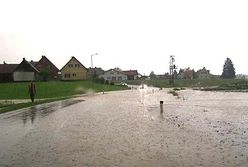
© FF PredingParts of Salzburg and Upper and Lower Austria were hit by heavy rain, hail and winds of up to 100 kilometres per hour (Mon/Tues).
Parts of Salzburg and Upper and Lower Austria were hit by heavy rain, hail and winds of up to 100 kilometres per hour as more bad weather battered Austria last night (Mon/Tues).
In Lower Austria alone 1,500 firemen were called out.
Rescuers helped an 84-year-old woman in Eggenburg, Lower Austria who had become disoriented in the rain and couldn't find her way back home as well as an Italian family cycling along the Danube River near Wallsee, Lower Austria who had lost their way in the rain.
High wind in Sitzenberg in Tulln district in Lower Austria blew 150 square metres of metal off the framework of a building under construction while lightning in Zwettl district in Lower Austria set two roofs on fire and started a forest fire nearby. It also started a blaze at an apartment in Brand and a set barn on fire in Schöngraben.
A mudslide in Gosau, Upper Austria hit 300 metres of a local highway, carrying some parked cars away and a pregnant woman, 31, was injured when a carriage she was riding in was overturned by a gust of wind in Upper Austria.
Weathermen have said rain will ease off tonight and tomorrow morning and tomorrow afternoon, Thursday and Friday will be mostly sunny before rain returns over the weekend.
Salzburg's northern Flachgau had already been hit by more heavy thunderstorms on Sunday less than two weeks after massive hail storms had left a trail of destruction in the area.


